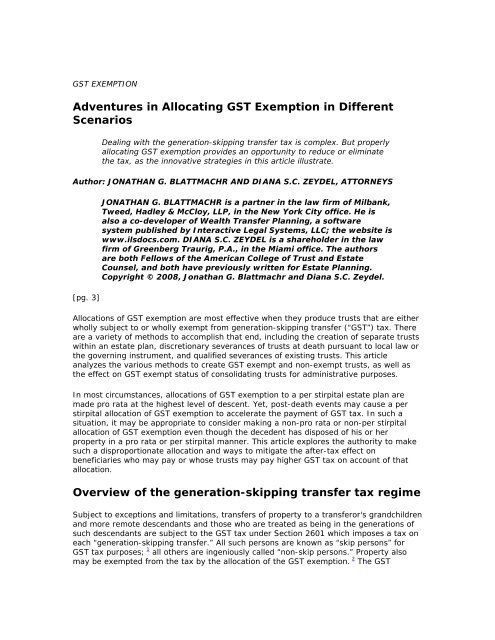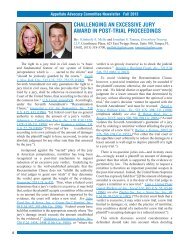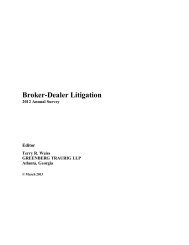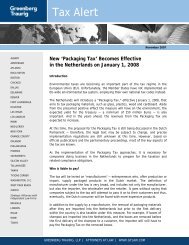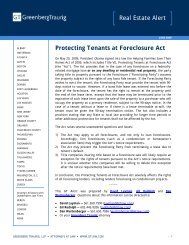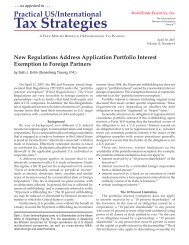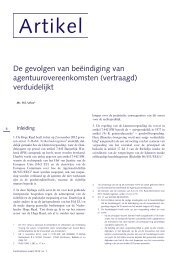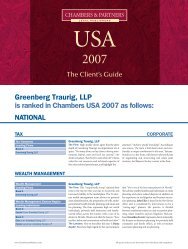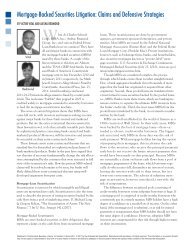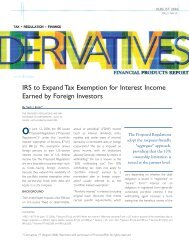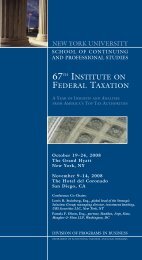Adventures in Allocating GST Exemption in Different Scenarios ...
Adventures in Allocating GST Exemption in Different Scenarios ...
Adventures in Allocating GST Exemption in Different Scenarios ...
You also want an ePaper? Increase the reach of your titles
YUMPU automatically turns print PDFs into web optimized ePapers that Google loves.
<strong>GST</strong> EXEMPTION<br />
<strong>Adventures</strong> <strong>in</strong> Allocat<strong>in</strong>g <strong>GST</strong> <strong>Exemption</strong> <strong>in</strong> <strong>Different</strong><br />
<strong>Scenarios</strong><br />
Deal<strong>in</strong>g with the generation-skipp<strong>in</strong>g transfer tax is complex. But properly<br />
allocat<strong>in</strong>g <strong>GST</strong> exemption provides an opportunity to reduce or elim<strong>in</strong>ate<br />
the tax, as the <strong>in</strong>novative strategies <strong>in</strong> this article illustrate.<br />
Author: JONATHAN G. BLATTMACHR AND DIANA S.C. ZEYDEL, ATTORNEYS<br />
[pg. 3]<br />
JONATHAN G. BLATTMACHR is a partner <strong>in</strong> the law firm of Milbank,<br />
Tweed, Hadley & McCloy, LLP, <strong>in</strong> the New York City office. He is<br />
also a co-developer of Wealth Transfer Plann<strong>in</strong>g, a software<br />
system published by Interactive Legal Systems, LLC; the website is<br />
www.ilsdocs.com. DIANA S.C. ZEYDEL is a shareholder <strong>in</strong> the law<br />
firm of Greenberg Traurig, P.A., <strong>in</strong> the Miami office. The authors<br />
are both Fellows of the American College of Trust and Estate<br />
Counsel, and both have previously written for Estate Plann<strong>in</strong>g.<br />
Copyright © 2008, Jonathan G. Blattmachr and Diana S.C. Zeydel.<br />
Allocations of <strong>GST</strong> exemption are most effective when they produce trusts that are either<br />
wholly subject to or wholly exempt from generation-skipp<strong>in</strong>g transfer (“<strong>GST</strong>”) tax. There<br />
are a variety of methods to accomplish that end, <strong>in</strong>clud<strong>in</strong>g the creation of separate trusts<br />
with<strong>in</strong> an estate plan, discretionary severances of trusts at death pursuant to local law or<br />
the govern<strong>in</strong>g <strong>in</strong>strument, and qualified severances of exist<strong>in</strong>g trusts. This article<br />
analyzes the various methods to create <strong>GST</strong> exempt and non-exempt trusts, as well as<br />
the effect on <strong>GST</strong> exempt status of consolidat<strong>in</strong>g trusts for adm<strong>in</strong>istrative purposes.<br />
In most circumstances, allocations of <strong>GST</strong> exemption to a per stirpital estate plan are<br />
made pro rata at the highest level of descent. Yet, post-death events may cause a per<br />
stirpital allocation of <strong>GST</strong> exemption to accelerate the payment of <strong>GST</strong> tax. In such a<br />
situation, it may be appropriate to consider mak<strong>in</strong>g a non-pro rata or non-per stirpital<br />
allocation of <strong>GST</strong> exemption even though the decedent has disposed of his or her<br />
property <strong>in</strong> a pro rata or per stirpital manner. This article explores the authority to make<br />
such a disproportionate allocation and ways to mitigate the after-tax effect on<br />
beneficiaries who may pay or whose trusts may pay higher <strong>GST</strong> tax on account of that<br />
allocation.<br />
Overview of the generation-skipp<strong>in</strong>g transfer tax regime<br />
Subject to exceptions and limitations, transfers of property to a transferor's grandchildren<br />
and more remote descendants and those who are treated as be<strong>in</strong>g <strong>in</strong> the generations of<br />
such descendants are subject to the <strong>GST</strong> tax under Section 2601 which imposes a tax on<br />
each “generation-skipp<strong>in</strong>g transfer.” All such persons are known as “skip persons” for<br />
<strong>GST</strong> tax purposes; 1 all others are <strong>in</strong>geniously called “non-skip persons.” Property also<br />
may be exempted from the tax by the allocation of the <strong>GST</strong> exemption. 2 The <strong>GST</strong>
exemption is equal to the amount of the applicable exclusion amount (also called the<br />
“estate tax exemption”) for estate tax purposes, currently $2 million.<br />
The <strong>GST</strong> exemption, however, is not a true exemption from <strong>GST</strong> tax, nor does it operate<br />
as a credit aga<strong>in</strong>st tax as the applicable exclusion amount does. Rather, it<br />
[pg. 3]<br />
is a rate reducer. The effective rate of generation-skipp<strong>in</strong>g tax (called the “applicable<br />
rate” 3 ) is determ<strong>in</strong>ed by multiply<strong>in</strong>g the “<strong>in</strong>clusion ratio,” 4 which essentially is the<br />
percentage of the property to which <strong>GST</strong> exemption has not been allocated, by the<br />
maximum federal estate tax rate (currently 45%). 5<br />
For example, an <strong>in</strong>dividual transfers $750,000 to a trust for her descendants and<br />
allocates $250,000 of <strong>GST</strong> exemption to the trust. 6 As a result, $500,000 of the<br />
$750,000 transferred to the trust (or two-thirds of the trust) is not “protected” from <strong>GST</strong><br />
tax or, <strong>in</strong> other words, the <strong>in</strong>clusion ratio of the trust is two-thirds. Hence, when a<br />
generation-skipp<strong>in</strong>g transfer from the trust occurs (for <strong>in</strong>stance, a distribution to a<br />
grandchild other than for medical needs or education 7 ), the effective tax rate is twothirds<br />
of the current highest rate listed for estate and gift tax purposes under Section<br />
2001(c). Under current law, this would produce a tax rate of 30% (2/3 of 45%). A trust<br />
all of which is protected from the tax by allocation of <strong>GST</strong> exemption has an <strong>in</strong>clusion<br />
ratio of zero. A trust none of which is so protected has an <strong>in</strong>clusion ratio of one.<br />
As <strong>in</strong>dicated, certa<strong>in</strong> transfers, even if not protected from <strong>GST</strong> tax by an allocation of <strong>GST</strong><br />
exemption, to or for skip persons are not subject to <strong>GST</strong> tax. These <strong>in</strong>clude transfers for<br />
tuition paid directly to the education <strong>in</strong>stitution and for medical care paid directly to the<br />
healthcare provider. 8<br />
Generally, if property may be subject only <strong>in</strong> part to <strong>GST</strong> tax (that is, it has an <strong>in</strong>clusion<br />
ratio of greater than zero but less than one), it usually is preferable to have separate<br />
trusts, 9 one or more of which would be entirely exempt from <strong>GST</strong> tax (that is, a zero<br />
<strong>in</strong>clusion ratio) and another or others that may be entirely subject to <strong>GST</strong> tax (an<br />
<strong>in</strong>clusion ratio of one). 10 One of the reasons is that distributions from a trust that would<br />
not be subject to <strong>GST</strong> tax, such as a distribution to a non-skip person or a distribution<br />
fall<strong>in</strong>g under the medical care or tuition exceptions for a skip person, may be made from<br />
a trust that is entirely subject to <strong>GST</strong> tax, thereby <strong>in</strong>creas<strong>in</strong>g what is available under the<br />
trust that is exempt from <strong>GST</strong> tax. Indeed, this is regarded as so important that the Code<br />
was amended <strong>in</strong> 2001 to allow “qualified severances” under which one trust that is only<br />
partially exempt from <strong>GST</strong> tax by reason of the allocation of <strong>GST</strong> exemption may be<br />
divided <strong>in</strong>to two trusts, one of which is totally <strong>GST</strong> exempt (that is, has a zero <strong>in</strong>clusion<br />
ratio) and one that is not exempt at all (that is, has an <strong>in</strong>clusion ratio of one). 11<br />
The taxpayer or the taxpayer's executor may allocate the taxpayer's unused <strong>GST</strong><br />
exemption so that a separate trust created under a decedent's estate plan is entirely<br />
exempt from <strong>GST</strong> tax while another trust is not exempt from <strong>GST</strong> tax. 12 Indeed, some<br />
practitioners direct, by word formula, 13 the disposition of <strong>in</strong>terests among descendants<br />
(or others) on the basis that there will be one trust for each beneficiary that is exempt<br />
from the tax and one trust that is not. Depend<strong>in</strong>g on whether the <strong>in</strong>dividual is married or<br />
not, the way that is accomplished may vary.<br />
Married persons and <strong>GST</strong> exemption allocation
Transfers to one's spouse are not subject to <strong>GST</strong> tax because a spouse is not a skip<br />
person. Also, transfers <strong>in</strong> qualify<strong>in</strong>g form 14 to or for one's spouse are not subject to gift<br />
or estate tax by reason of the marital deduction. 15 But many, if not most, married<br />
persons with appreciable wealth do not transfer all their property at death to their<br />
spouses under the protection of the marital deduction. That would “waste” the estate tax<br />
exemption of the spouse dy<strong>in</strong>g first because property sheltered from estate tax by the<br />
exemption need not be taxed<br />
[pg. 6]<br />
when the surviv<strong>in</strong>g spouse dies but property protected by the marital deduction will be<br />
(unless expended dur<strong>in</strong>g the surviv<strong>in</strong>g spouse's lifetime). Accord<strong>in</strong>gly, married persons at<br />
death often provide for the division of their estates <strong>in</strong>to at least two shares: one that is<br />
protected from estate tax by reason of the estate tax exemption and another qualify<strong>in</strong>g<br />
for the marital deduction. 16<br />
In many cases, the amount of unused <strong>GST</strong> exemption of a decedent will be different from<br />
the amount of his or her unused estate tax exemption. One reason is that lifetime gifts<br />
may use a portion of the estate tax exemption but not necessarily <strong>GST</strong> exemption. 17 In a<br />
case where the unused <strong>GST</strong> exemption exceeds the unused estate tax exemption, a<br />
married decedent will waste his or her <strong>GST</strong> exemption by divid<strong>in</strong>g his or her estate <strong>in</strong>to<br />
only two shares, one equal to the estate tax exemption and the balance qualify<strong>in</strong>g for the<br />
marital deduction. This is so because a portion of his or her <strong>GST</strong> exemption will be<br />
allocated to property with respect to which the surviv<strong>in</strong>g spouse will become the<br />
transferor for <strong>GST</strong> tax purposes. 18<br />
This would happen, for example, if the executor of the will of the first spouse to die<br />
makes an election under Section 2056(b)(7) to treat a trust for the surviv<strong>in</strong>g spouse as<br />
qualified term<strong>in</strong>able <strong>in</strong>terest property (“QTIP”) which would cause the trust estate to be<br />
<strong>in</strong>cluded <strong>in</strong> the surviv<strong>in</strong>g spouse's estate under Section 2044. But Section 2652(a)(3)<br />
allows a taxpayer or the taxpayer's executor who makes an election to treat a transfer<br />
that has qualified for the gift or estate tax marital deduction by reason of elect<strong>in</strong>g it to<br />
constitute QTIP to treat the QTIP election, for <strong>GST</strong> tax purposes, as though never made.<br />
In other words, although an election is made for estate tax purposes for the transfer to<br />
qualify for the marital deduction as QTIP, the election is reversed for <strong>GST</strong> tax purposes.<br />
Such a “Reverse QTIP” election permits the taxpayer or his or her executor to treat the<br />
taxpayer as the transferor for <strong>GST</strong> tax purposes so that his or her <strong>GST</strong> exemption may be<br />
allocated to the QTIP trust. Thus, when the spouse who is the beneficiary of the Reverse<br />
QTIP trust dies, the property will rema<strong>in</strong> exempt from <strong>GST</strong> tax without further allocation<br />
of <strong>GST</strong> exemption.<br />
In fact, to accomplish that result, many married <strong>in</strong>dividuals do not direct a two-part<br />
division of their wealth at death (estate tax exemption part and marital deduction part)<br />
but direct a three-part division: (1) one part equal to the amount of his or her unused<br />
estate tax exemption, usually pass<strong>in</strong>g <strong>in</strong>to a trust for the spouse and descendants<br />
(sometimes called the “credit shelter trust” 19 or “estate tax exemption trust”); (2) one<br />
part equal to the amount by which the unused <strong>GST</strong> exemption exceeds the unused estate<br />
tax exemption, pass<strong>in</strong>g <strong>in</strong>to a Reverse QTIP trust, and (3) the balance pass<strong>in</strong>g <strong>in</strong> a form<br />
(such as a second QTIP but with respect to which the Reverse QTIP election will not be<br />
made) that will qualify for the marital deduction but which will not be exempt from <strong>GST</strong><br />
tax by reason of the <strong>GST</strong> exemption of the first spouse to die. 20
Hence, when the surviv<strong>in</strong>g spouse dies, the property rema<strong>in</strong><strong>in</strong>g <strong>in</strong> the estate tax<br />
exemption trust and the Reverse QTIP trust will be exempt from <strong>GST</strong> tax by reason of the<br />
allocation to those trusts of the <strong>GST</strong> exemption of the spouse dy<strong>in</strong>g first.<br />
Of course, the surviv<strong>in</strong>g spouse, as with any other decedent, may have unused <strong>GST</strong><br />
exemption at his or her death. As <strong>in</strong>dicated above, non-married persons often direct the<br />
division of their wealth <strong>in</strong>to <strong>GST</strong> exempt and <strong>GST</strong> non-exempt shares.<br />
To m<strong>in</strong>imize applicable estate and <strong>GST</strong> taxes, the number of trusts follow<strong>in</strong>g the death of<br />
the surviv<strong>in</strong>g spouse may be significant. Without any comb<strong>in</strong>ation of the succeed<strong>in</strong>g<br />
trusts, as is discussed next, even if each of the three parts of the estate of the first<br />
spouse to die passes <strong>in</strong>to one s<strong>in</strong>gle trust for all descendants, there may be at least three<br />
such trusts created from such property because there were three shares: (1) estate tax<br />
exemption trust, (2) Reverse QTIP trust, and (3) a second QTIP trust. Aga<strong>in</strong>, even if the<br />
property of the surviv<strong>in</strong>g spouse is to be held <strong>in</strong> s<strong>in</strong>gle trusts for all descendants, there<br />
will be at least two shares: (1) one equal to the unused <strong>GST</strong> exemption of the surviv<strong>in</strong>g<br />
spouse, and (2) the balance of his or her property. Consequently, there could be as many<br />
as five trusts for the descendants when the first spouse dies.<br />
And, of course, if the couple wishes a per stirpital division of their wealth, as many<br />
property owners do, <strong>in</strong>stead of five trusts,<br />
[pg. 7]<br />
there may be fives times the number of per stirpital shares. For <strong>in</strong>stance, if the couple<br />
has two children, both of whom survive, there could be ten trusts, five for each child. If a<br />
child has predeceased the parents, leav<strong>in</strong>g two children of his or her own, there would be<br />
15 trusts: five for the surviv<strong>in</strong>g child and five for each of the two grandchildren (although<br />
the trusts for grandchildren would be half the size of the ones for the surviv<strong>in</strong>g child).<br />
Reduc<strong>in</strong>g the number of trusts<br />
Although Section 643(f) provides that trusts hav<strong>in</strong>g substantially the same grantor or<br />
grantors (and a husband and wife are treated as one grantor for purposes of the section)<br />
and substantially the same primary beneficiary or beneficiaries may be treated as one<br />
trust for <strong>in</strong>come tax purposes, that does not seem likely to cause the five or so trusts for<br />
the same descendant created <strong>in</strong> the forego<strong>in</strong>g manner by a married couple to be treated<br />
as one trust because the section applies only if a pr<strong>in</strong>cipal purpose of such trusts is the<br />
avoidance of <strong>in</strong>come tax. Such tax avoidance is unlikely to be found to be a pr<strong>in</strong>cipal<br />
purpose for the creation of the trusts. Rather, it was done efficiently to use the estate<br />
and <strong>GST</strong> exemptions of the first spouse to die and the <strong>GST</strong> exemption of the surviv<strong>in</strong>g<br />
spouse. Although each such trust, therefore, is considered a separate taxpayer, the<br />
<strong>in</strong>come tax benefit of the $300 or $100 personal exemption for each trust 21 and the<br />
modest “bracket ride” likely may not be perceived as sufficiently beneficial to justify<br />
keep<strong>in</strong>g separate trusts. 22<br />
In any case, where it is not anticipated that separate trusts will produce a significant<br />
<strong>in</strong>come tax benefit or produce another benefit that would suggest it would be efficient for<br />
separate trusts to be ma<strong>in</strong>ta<strong>in</strong>ed, it seems appropriate to consider consolidat<strong>in</strong>g at least<br />
some of the trusts. 23 How that may be accomplished may turn on the terms of the<br />
govern<strong>in</strong>g <strong>in</strong>strument and state law.
For <strong>in</strong>stance, many practitioners expressly provide that fiduciaries may comb<strong>in</strong>e trusts<br />
held under the govern<strong>in</strong>g <strong>in</strong>strument for the same beneficiary or beneficiaries if the terms<br />
of the trust are identical. Hence, if, by way of example, the estate tax exempt trust and<br />
the Reverse QTIP trust that the first spouse to die creates pass <strong>in</strong>to identical trusts, these<br />
trusts presumably could be comb<strong>in</strong>ed by such an authorization. If the <strong>in</strong>strument is<br />
silent, state law may authorize such a comb<strong>in</strong>ation. For example, statutes <strong>in</strong> six states<br />
permit a trustee with a power to <strong>in</strong>vade the corpus of a trust to pay the corpus over to<br />
another trust for one or more of the persons to whom the trustee could make<br />
discretionary distributions of corpus. 24 In some cases,<br />
[pg. 8]<br />
however, it will be uncerta<strong>in</strong> whether the power to comb<strong>in</strong>e the trusts, even for the same<br />
beneficiary or beneficiaries, is available. It may then be considered whether seek<strong>in</strong>g<br />
authorization from a court hav<strong>in</strong>g jurisdiction over the trusts is appropriate and would be<br />
successful. 25<br />
As <strong>in</strong>dicated above, even if consolidation of the trusts orig<strong>in</strong>at<strong>in</strong>g with the property of the<br />
first spouse to die is permitted, it seems unwise to consolidate any trust that is <strong>GST</strong><br />
exempt with one that is not. Nevertheless, a special <strong>GST</strong> tax rule would permit the<br />
consolidation of all three trusts, even if the non-Reverse QTIP is not <strong>GST</strong> exempt, without<br />
creat<strong>in</strong>g a trust with a fractional <strong>in</strong>clusion ratio.<br />
Section 2654(b)(1) provides that, for purposes of the <strong>GST</strong> tax, the portions of a trust<br />
attributable to transfers from different transferors are treated as separate trusts. And the<br />
surviv<strong>in</strong>g spouse will become the transferor for <strong>GST</strong> purposes of the non-Reverse QTIP<br />
trust because the non-Reverse QTIP trust is <strong>in</strong>cludable <strong>in</strong> the surviv<strong>in</strong>g spouse's estate<br />
under Section 2044. 26 Because the surviv<strong>in</strong>g spouse will be treated as the transferor of<br />
the third part of the estate of the first spouse to die, it can be consolidated with the other<br />
parts (the estate tax exemption trust and Reverse QTIP trust) of the estate of the first<br />
spouse to die that are <strong>GST</strong> exempt, and the third part will be treated as a separate trust.<br />
Therefore, even though the third part may not be exempt from <strong>GST</strong> tax, the trustee of<br />
the consolidated trust may specify when a distribution is made whether it is from the<br />
property of which the first spouse to die is the transferor or of which the surviv<strong>in</strong>g spouse<br />
is the transferor for <strong>GST</strong> tax purposes. 27<br />
Of course, the surviv<strong>in</strong>g spouse may have unused <strong>GST</strong> exemption of his or her own. Any<br />
such exemption could be allocated to the third part of the estate of the first spouse to die<br />
of which the surviv<strong>in</strong>g spouse will be treated as the transferor. If the <strong>GST</strong> exemption of<br />
the first spouse to die is sufficient to exempt the entire third part from <strong>GST</strong> tax and it is<br />
allocated to that part, that may simplify adm<strong>in</strong>istration of the consolidated trust because<br />
it is likely to be unimportant for <strong>GST</strong> tax purposes to determ<strong>in</strong>e whether a distribution is<br />
attributable to property of which the spouse dy<strong>in</strong>g first is the transferor or is attributable<br />
to property of which the survivor is the transferor.<br />
In fact, the unused <strong>GST</strong> exemption of the surviv<strong>in</strong>g spouse may be sufficient to exempt<br />
not just the third part of the estate of the first spouse to die from the tax but also the<br />
surviv<strong>in</strong>g spouse's own property. In such a case, it may seem simplest to consolidate all<br />
of his and her property together <strong>in</strong>to one trust. That might occur under a consolidation<br />
authorization under all govern<strong>in</strong>g <strong>in</strong>struments or state law, as discussed above. And it<br />
may be that decant<strong>in</strong>g power is present under the common law of states that do have a<br />
“decant<strong>in</strong>g” statute. 28
But where the trusts created by the first spouse to die and the surviv<strong>in</strong>g spouse have<br />
different term<strong>in</strong>ation terms (such as each such trust hav<strong>in</strong>g to term<strong>in</strong>ate not later than<br />
the maximum term permitted by the applicable rule aga<strong>in</strong>st perpetuities which began<br />
when respective trust's grantor died), it may not be appropriate to consolidate all of them<br />
to ensure compliance with the rule. This is true even though, because the husband and<br />
wife are treated as different transferors, it seems that there should be no limit <strong>in</strong><br />
consolidat<strong>in</strong>g the trusts from a <strong>GST</strong> tax perspective. And as long as the trusts are<br />
identical, there would not seem to be any adverse <strong>in</strong>come tax effect by such<br />
consolidation. 29<br />
To ensure that any consolidation would satisfy the applicable limitation on the duration of<br />
trusts, a decant<strong>in</strong>g power could be used to help achieve an appropriate result. The<br />
trustee <strong>in</strong> mak<strong>in</strong>g the <strong>in</strong>vasion <strong>in</strong> further trust under a decant<strong>in</strong>g power could specify that<br />
the applicable rule aga<strong>in</strong>st perpetuities with respect to the <strong>in</strong>vaded trust shall apply under<br />
the consolidated trust as to the property of the <strong>in</strong>vaded trust. Alternatively, it may be<br />
“safer” to have the trust with the longer rema<strong>in</strong><strong>in</strong>g term paid over to the trust with the<br />
shorter term but with a direction that the addition be subject, to the extent permitted by<br />
applicable law, to the longer rema<strong>in</strong><strong>in</strong>g term. Depend<strong>in</strong>g on the tim<strong>in</strong>g of the deaths of<br />
husband and wife, subject<strong>in</strong>g all the property to the shorter term may be satisfactory.<br />
If the unused rema<strong>in</strong><strong>in</strong>g <strong>GST</strong> exemption of the surviv<strong>in</strong>g spouse is <strong>in</strong>sufficient to permit<br />
all the property with respect to which the survivor is the transferor for <strong>GST</strong> tax purposes<br />
to be exempted from <strong>GST</strong> tax, it may not be appropriate to consolidate all the property<br />
(that is, property that is <strong>GST</strong> exempt and property that is not) <strong>in</strong>to one trust. The<br />
“different” transferors rule of Section 2654(b)(1) discussed above will not apply to<br />
prevent the<br />
[pg. 9]<br />
consolidated trust with respect to the surviv<strong>in</strong>g spouse to be only partly exempt from tax.<br />
Moreover, if the <strong>GST</strong> exempt and <strong>GST</strong> non-exempt parts of the property with respect to<br />
which the surviv<strong>in</strong>g spouse is the transferor are similar as they likely would be, the<br />
substantially separate and <strong>in</strong>dependent shares rule of Section 2654(b)(2) will not be<br />
available to prevent the consolidated trust from be<strong>in</strong>g only partly <strong>GST</strong> exempt.<br />
In light of the forego<strong>in</strong>g discussion, it will not be possible to consolidate down to one trust<br />
and ma<strong>in</strong>ta<strong>in</strong> <strong>GST</strong> exemption purity (that is, an <strong>in</strong>clusion ratio of zero) for part. It may be<br />
simplest to consolidate all parts that are <strong>GST</strong> exempt, regardless of which spouse is the<br />
transferor, <strong>in</strong>to one trust, and all parts that are not <strong>GST</strong> exempt <strong>in</strong>to a second trust.<br />
Qualified severance or no?<br />
In general, the Regulations under Section 2654 permit a trust <strong>in</strong>cludable <strong>in</strong> the<br />
decedent's estate to be severed or divided <strong>in</strong>to parts on a fractional share basis, for<br />
purposes for allocat<strong>in</strong>g <strong>GST</strong> exemption to one of the parts, if the division occurs before<br />
the date, <strong>in</strong>clud<strong>in</strong>g extensions, prescribed for fil<strong>in</strong>g the United States Estate (and<br />
Generation-Skipp<strong>in</strong>g Transfer) Tax Return (Form 706) and is pursuant to an authorization<br />
for such severance under local law or the terms of the govern<strong>in</strong>g <strong>in</strong>strument (or is<br />
required by it). 30 Under a special rule, if the division will occur pursuant to a local court<br />
order, and the court order sever<strong>in</strong>g the trust has not been issued at the time the federal<br />
estate tax return is filed, the executor must <strong>in</strong>dicate on a statement attached to the<br />
return that a proceed<strong>in</strong>g has been commenced to sever the trust and describe the<br />
manner <strong>in</strong> which the trust is proposed to be severed. A copy of the petition or other<br />
<strong>in</strong>strument used to commence the proceed<strong>in</strong>g must also be attached to the return.
On the other hand, if the govern<strong>in</strong>g <strong>in</strong>strument of a trust or local law authorizes the<br />
division of the trust, a severance pursuant to that authorization is recognized if the<br />
executor <strong>in</strong>dicates on the federal estate tax return that separate trusts will be created (or<br />
funded) and clearly sets forth the manner <strong>in</strong> which the trust is to be severed and the<br />
separate trusts funded even if the severance has not taken place at the time the return is<br />
filed. This rule puts a premium on draft<strong>in</strong>g authorization <strong>in</strong> the govern<strong>in</strong>g <strong>in</strong>strument to<br />
ensure maximum flexibility. New Example (3) under Reg. 26.2654-1(b) confirms that a<br />
severance pursuant to authority under applicable state law is valid if accomplished before<br />
the due date for fil<strong>in</strong>g the federal estate tax return, but does not provide guidance on<br />
what would be a sufficient statement by the executor if the severance is delayed until<br />
after the return is filed. 31<br />
A trust which has an <strong>in</strong>clusion ratio of more than zero and less than one may be divided<br />
so that one severed trust has an <strong>in</strong>clusion ratio of zero (totally <strong>GST</strong> exempt) and the<br />
other has an <strong>in</strong>clusion ratio of one (no part is <strong>GST</strong> exempt) pursuant to a “qualified<br />
severance.” 32 A "qualified severance" means the division of a s<strong>in</strong>gle trust and the<br />
creation (by any means available under the govern<strong>in</strong>g <strong>in</strong>strument or under local law) of<br />
two or more trusts, if the s<strong>in</strong>gle trust was divided on a fractional basis, and the terms of<br />
the new trusts, <strong>in</strong> the aggregate, provide for the same succession of <strong>in</strong>terests of<br />
beneficiaries as are provided <strong>in</strong> the orig<strong>in</strong>al trust. However, a qualified severance does<br />
not <strong>in</strong>clude a severance pursuant to Reg. 26.2654-1(b), described <strong>in</strong> the forego<strong>in</strong>g<br />
paragraph of this article. 33 The reason is that the severance pursuant to that Regulation<br />
is effective retroactive to the date of the decedent's death; a qualified severance is<br />
effective only when made. Generally, it may be preferable to effect the severance for<br />
property <strong>in</strong>cluded <strong>in</strong> a decedent's estate pursuant to Reg. 26.2654-1(b) rather than by a<br />
qualified severance.<br />
Disproportionate allocation of <strong>GST</strong> exemption<br />
As <strong>in</strong>dicated, transfers to skip persons may be subject to two taxes: (1) a gift or estate<br />
tax, and (2) a <strong>GST</strong> tax. When the transfer is a direct skip (essentially one to, or at least<br />
<strong>in</strong>itially for the exclusive benefit of, skip persons), the two taxes are imposed<br />
simultaneously. 34 However, where the property subject to gift or estate tax is transferred<br />
to a trust <strong>in</strong> which a non-skip person (such as a child) currently has an <strong>in</strong>terest, 35 the<br />
<strong>GST</strong> tax is postponed until a distribution to a skip person is made or the <strong>in</strong>terests <strong>in</strong> the<br />
trust of the non-skip person or persons term<strong>in</strong>ate. 36<br />
Property is often subject to estate tax <strong>in</strong> the estate of more than one person. For<br />
example, property subject to estate tax when it is <strong>in</strong>herited by a child from a parent<br />
[pg. 10]<br />
may be subject to estate tax aga<strong>in</strong> when the child dies. However, a credit (subject to<br />
limits) <strong>in</strong> one estate for the estate tax paid <strong>in</strong> the other estate is available when one<br />
death follows the other with<strong>in</strong> ten years or, <strong>in</strong> some cases, precedes it by two years. 37<br />
No similar relief is provided when property is subject to estate or gift tax and a<br />
generation-skipp<strong>in</strong>g skipp<strong>in</strong>g event occurs soon thereafter. For example, suppose that a<br />
parent creates a trust for her child which will end when the child dies <strong>in</strong> favor of the<br />
child's children. The child dies a year after the parent dies. A <strong>GST</strong> tax will be due except<br />
to the extent the trust is <strong>in</strong>cluded <strong>in</strong> the child's gross estate for federal estate tax<br />
purposes 38 or allocation of <strong>GST</strong> exemption has protected the trust from that tax.
A special rule under Section 2651(e) provides that if a descendant of the transferor<br />
predeceases the transfer that is subject to estate tax or gift tax (which could be at the<br />
same time as the <strong>GST</strong> transfer, <strong>in</strong> the case of a direct skip, or could precede the <strong>GST</strong><br />
transfer, <strong>in</strong> the case of a taxable term<strong>in</strong>ation or a taxable distribution), then the deceased<br />
descendant's own descendants “move up” to the next “higher” generation. For example,<br />
suppose that a child predeceases her father leav<strong>in</strong>g a son (a grandson of her father). For<br />
<strong>GST</strong> tax purposes, that grandson is treated as the grandfather's child so that no<br />
generation-skipp<strong>in</strong>g transfer is deemed to occur with respect to transfers to or for that<br />
grandson from the grandfather's gross estate (or any gift he makes to or for the<br />
grandson) after the daughter has died. 39 (A similar rule applies with respect to certa<strong>in</strong><br />
collateral relatives of the transferor <strong>in</strong> certa<strong>in</strong> circumstances. 40 )<br />
The Regulations provide that any <strong>in</strong>dividual who dies no later than 90 days after a<br />
transfer occurr<strong>in</strong>g by reason of the death of the transferor is treated as hav<strong>in</strong>g<br />
predeceased the transferor. 41 Accord<strong>in</strong>gly, by way of example, if a child dies with<strong>in</strong> 90<br />
days of his or her parent, he or she will be treated as predeceas<strong>in</strong>g the parent so that the<br />
children of the child “move up” to the child's generation, and no <strong>GST</strong> tax would be<br />
imposed on a testamentary transfer to or for the child's children. Similarly, if the parent<br />
creates a testamentary trust for the benefit of her son which will cont<strong>in</strong>ue for the son's<br />
children (her grandchildren) when he dies, no generation-skipp<strong>in</strong>g transfer would be<br />
deemed to occur (and, as a result, no <strong>GST</strong> tax imposed) if the son dies with<strong>in</strong> 90 days of<br />
his mother because his children “move up” to his generation for <strong>GST</strong> tax purposes.<br />
On the other hand, if the son survived for more than 90 days, the move-up-a-generation<br />
rule would not apply and, unless <strong>GST</strong> exemption is allocated to the trust, <strong>GST</strong> tax will be<br />
imposed when the son dies and the trust cont<strong>in</strong>ues for his children. If the son's death<br />
occurs more than 90 days after the parent dies but before the United States Estate (and<br />
Generation-Skipp<strong>in</strong>g Transfer) Tax Return (Form 706) is required to be filed, the executor<br />
of the parent's will could allocate <strong>GST</strong> exemption to the trust for the son to reduce or<br />
elim<strong>in</strong>ate <strong>GST</strong> tax. But if a proportionate allocation of <strong>GST</strong> exemption is not sufficient to<br />
reduce the <strong>in</strong>clusion ratio of the trust for the son to zero, the executor faces the fiduciary<br />
dilemma of <strong>in</strong>curr<strong>in</strong>g current <strong>GST</strong> tax or mak<strong>in</strong>g a disproportionate allocation.<br />
For <strong>in</strong>stance, suppose a decedent, with all of her $2 million <strong>GST</strong> exemption unused at<br />
death, is survived by five children, and has bequeathed her $3 million estate after estate<br />
tax <strong>in</strong> equal trusts for her children; each such $600,000 trust is to be held until the<br />
applicable rule aga<strong>in</strong>st perpetuities expires. Her oldest daughter dies with<strong>in</strong> 90 days of<br />
the decedent and her oldest son dies thereafter but before the estate tax return is due to<br />
be filed. If the executor allocates the <strong>GST</strong> exemption proportionately (that is, $400,000<br />
to each trust), <strong>GST</strong> tax would be due on the death of the oldest son on about $200,000<br />
(or, if there has been no severance between a <strong>GST</strong> exempt and <strong>GST</strong> non-exempt<br />
portions, a <strong>GST</strong> tax on the entire son's trust at a rate of one-third of the highest estate<br />
tax rate <strong>in</strong> effect at the son's death).<br />
Under Section 2631(a), the executor is authorized to allocate <strong>GST</strong> exemption without<br />
limitation. Hence, to avoid the current imposition of <strong>GST</strong> tax, the executor could allocate<br />
$600,000 of the decedent's $2 million <strong>GST</strong> exemption to the trust for the benefit of the<br />
oldest son. Under the wise old accountant's adage “a tax dollar delayed may never be<br />
paid,” that seems sensible. Another step that could reduce but not elim<strong>in</strong>ate <strong>GST</strong> tax<br />
might be for a disclaimer under Section 2518 to be made on behalf of a child who dies<br />
after 90 days but with<strong>in</strong> n<strong>in</strong>e months of the parent's death. 42<br />
However, the disproportionate allocation of <strong>GST</strong> exemption means more <strong>GST</strong> tax will be<br />
payable when a generation-skipp<strong>in</strong>g transfer occurs with respect with to the other trusts.<br />
Indeed, even though
[pg. 11]<br />
the trust for the benefit of the oldest daughter was not subject to <strong>GST</strong> tax because the<br />
daughter died with<strong>in</strong> 90 days of her mother's death, that trust will be subject to the tax<br />
when the daughter's children die if the property passes to or for persons who can be<br />
treated as be<strong>in</strong>g the generation of the decedent's grandchildren (which would be the<br />
decedent's great-grandchildren) or more remote descendants. Whether that event will, <strong>in</strong><br />
fact, occur or is likely to occur before or after the other children of the decedent die,<br />
caus<strong>in</strong>g <strong>GST</strong> tax to be imposed, may be difficult to forecast.<br />
It would seem that tim<strong>in</strong>g is not the only factor, and it may be appropriate for the<br />
executor to consider the probable imposition of <strong>GST</strong> tax on a generational basis. In other<br />
words, as <strong>in</strong> the case of the decedent's own children, unnatural or early deaths may<br />
occur. However, an appropriate manner to determ<strong>in</strong>e the allocation of <strong>GST</strong> exemption<br />
and the future adm<strong>in</strong>istration of the trusts might be to attempt to deliver a comparable<br />
level of property to the grandchildren <strong>in</strong> each l<strong>in</strong>e of descent while at the same time<br />
avoid<strong>in</strong>g the current imposition of <strong>GST</strong> tax. Such a determ<strong>in</strong>ation may be appropriate<br />
notwithstand<strong>in</strong>g that a disproportionate allocation of <strong>GST</strong> exemption may subject all the<br />
trusts (other than the one for the oldest son) to greater <strong>GST</strong> tax than if the allocation had<br />
been pro rata.<br />
Federal law does not appear to require any proportionate or other type of allocation of<br />
<strong>GST</strong> exemption. However, does local law limit the manner <strong>in</strong> which an executor makes<br />
the <strong>GST</strong> exemption allocation? It seems little, if any, law has developed <strong>in</strong> that regard.<br />
Lower court cases 43 suggest that a fiduciary who would benefit from a disproportionate<br />
allocation of tax benefits <strong>in</strong> his or her favor may be prohibited from mak<strong>in</strong>g one. On the<br />
other hand, no law seems to prohibit a “dis<strong>in</strong>terested” fiduciary from mak<strong>in</strong>g a<br />
disproportionate allocation. That may suggest that a fiduciary would not be liable for<br />
mak<strong>in</strong>g one, at least where there is an apparent reason to do so.<br />
It seems that a decision to make a disproportionate allocation of <strong>GST</strong> exemption to<br />
prevent an “early” imposition of <strong>GST</strong> tax does not seem unreasonable. The imposition of<br />
a current tax otherwise would be a virtual certa<strong>in</strong>ty. A subsequent imposition of <strong>GST</strong> tax<br />
on the trusts may not occur for several reasons, <strong>in</strong>clud<strong>in</strong>g a repeal of the tax, 44<br />
distributions that are exempt from the tax, 45 the imposition of gift or estate tax with<br />
respect to beneficiaries the term<strong>in</strong>ation of whose <strong>in</strong>terests would generate the tax, 46 the<br />
distribution of the trust property to the beneficiary the term<strong>in</strong>ation of whose <strong>in</strong>terest<br />
would generate the tax, or the term<strong>in</strong>ation of the trust <strong>in</strong> favor of non-skip persons. 47<br />
That may mean an action aga<strong>in</strong>st the executor who makes a disproportionate allocation<br />
of <strong>GST</strong> exemption to avoid an immediate tax could not be effectively ma<strong>in</strong>ta<strong>in</strong>ed. Indeed,<br />
<strong>in</strong> somewhat analogous circumstances discussed below, it seems no such action has ever<br />
been commenced aga<strong>in</strong>st an executor. But that case law suggests that local law will<br />
restore the “lost” tax benefit to the beneficiaries who did not receive a proportionate<br />
allocation of the benefit. And this reflects that fiduciaries often have to make decisions<br />
with respect to the many tax decisions that fiduciaries make that favor one beneficiary<br />
over another. 48<br />
One of the most common tax “elections” an executor makes is<br />
[pg. 12]<br />
whether to use estate adm<strong>in</strong>istration expenses as estate tax deductions 49 or as <strong>in</strong>come<br />
tax deductions. 50 Usually, the executor will choose to take the deduction where the
greatest amount of tax will be saved. That decision may have two ramifications. If the<br />
deduction is used for estate tax purposes, estate tax will be lower than if the deduction<br />
had been taken for <strong>in</strong>come tax purposes. Also, <strong>in</strong> general, an <strong>in</strong>come tax deduction will<br />
benefit the current beneficiaries because it will reduce the amount of taxable <strong>in</strong>come of<br />
the estate, enhanc<strong>in</strong>g the after-tax <strong>in</strong>come available for those beneficiaries. In contrast,<br />
the burden of the estate tax may be viewed as fall<strong>in</strong>g upon the successor trust<br />
beneficiaries (e.g., the rema<strong>in</strong>der persons).<br />
A somewhat similar consequence occurred <strong>in</strong> Matter of Warms. 51 In that case, the<br />
executor had elected, pursuant to the 1939 Internal Revenue Code predecessor of<br />
Section 642(g), to use estate adm<strong>in</strong>istration expenses, which under local law were<br />
chargeable aga<strong>in</strong>st the pr<strong>in</strong>cipal account, as <strong>in</strong>come tax deductions rather than as estate<br />
tax deductions. The election had two direct ramifications to the estate beneficiaries: (1) it<br />
reduced the amount of the estate's taxable <strong>in</strong>come and because <strong>in</strong>come taxes were<br />
chargeable under local law to the <strong>in</strong>come account, the value of the <strong>in</strong>come account was<br />
enhanced over what it would have been if the expenses had been taken as an estate tax<br />
deduction, and (2) the amount of estate taxes, which together with the adm<strong>in</strong>istration<br />
expenses were chargeable to the corpus account, was <strong>in</strong>creased over what they would<br />
have been had the adm<strong>in</strong>istration expenses been used as an estate tax deduction,<br />
dim<strong>in</strong>ish<strong>in</strong>g the corpus account.<br />
In the court's view, it was <strong>in</strong>appropriate for the <strong>in</strong>come account to receive the tax benefit<br />
through a deduction of expenses paid by the pr<strong>in</strong>cipal account (when the effect was to<br />
<strong>in</strong>crease the tax burden on the corpus account). The court ordered the <strong>in</strong>come account to<br />
reimburse the corpus account <strong>in</strong> the amount of the <strong>in</strong>crease <strong>in</strong> estate tax that resulted<br />
from us<strong>in</strong>g the expenses as an <strong>in</strong>come tax rather than an estate tax deduction. In other<br />
words, the court “equitably adjusted” the <strong>in</strong>terests of the <strong>in</strong>come and rema<strong>in</strong>der<br />
beneficiaries to restore the rema<strong>in</strong>der beneficiary to the same position had the expenses<br />
been deducted for estate tax purposes.<br />
Interest<strong>in</strong>gly, the adjustment was measured by the detriment to the corpus account of<br />
the tax election, not by the benefit to the <strong>in</strong>come account. As has been observed, almost<br />
all courts that have faced circumstances where a tax election produced a result that<br />
seemed unfair as a matter of local law, have ordered such an “equitable adjustment” with<br />
respect to the rema<strong>in</strong><strong>in</strong>g <strong>in</strong>terests <strong>in</strong> the estate or trust. 52<br />
It seems that such an equitable adjustment also may be the appropriate remedy to use<br />
where the executor has made a disproportionate allocation of <strong>GST</strong> exemption for<br />
reasonable cause. The court, however, might wait to make any equitable adjustment to<br />
see if the disproportionate allocation has resulted <strong>in</strong> a greater tax than if a proportionate<br />
allocation were made. Whether there could be <strong>GST</strong> tax consequences if such an equitable<br />
adjustment is made is uncerta<strong>in</strong>. In Matter of Warms, the adjustment was made with<strong>in</strong><br />
the conf<strong>in</strong>es of the same trust although from the <strong>in</strong>terests of one beneficiary to another.<br />
On the other hand, if such an adjustment were to cause property to be paid between<br />
trusts, the issue of a constructive addition to the recipient trust arises (which might mean<br />
a change <strong>in</strong> the trust's <strong>in</strong>clusion ratio or caus<strong>in</strong>g the trust to have another transferor). If<br />
the adjustment causes the movement of property from a <strong>GST</strong> exempt trust to one that is<br />
entirely non-exempt, there may be no <strong>GST</strong> tax issue. One might also conclude that the<br />
recipient trust has a claim for restoration so that the adjustment is <strong>in</strong> satisfaction of an<br />
obligation to the recipient trust (rather than <strong>in</strong> the nature of a distribution) and,<br />
therefore, cannot be an addition for <strong>GST</strong> tax purposes.
It seems there can be no addition to any trust for <strong>GST</strong> tax purposes unless some<br />
<strong>in</strong>dividual is treated as mak<strong>in</strong>g a gift. “If the equitable adjustment is required as a matter<br />
of local law, it seems doubtful that mak<strong>in</strong>g the adjustment is a transfer subject to the gift<br />
tax.” 53 That, of course, raises the other side of the issue if the trustee, or the trust's<br />
beneficiaries, of the disadvantaged trust do not seek such an adjustment. Draft<strong>in</strong>g to<br />
afford the executor<br />
[pg. 13]<br />
sufficient authority to address these issues seems the best solution.<br />
Moreover, careful adm<strong>in</strong>istration of the trusts that did not receive a proportionate<br />
allocation of <strong>GST</strong> exemption may elim<strong>in</strong>ate the loss of benefit from the disproportionate<br />
allocation.<br />
Adm<strong>in</strong>ister<strong>in</strong>g <strong>GST</strong> exempt and non-exempt trusts<br />
In the forego<strong>in</strong>g example, each of the $600,000 trusts, other than the one for the oldest<br />
son, would receive an allocation of only $350,000 of the decedent's <strong>GST</strong> exemption,<br />
rather than $400,000 as a result of the allocation of $600,000 <strong>in</strong> <strong>GST</strong> exemption to the<br />
oldest son's trust to protect it from an immediate <strong>GST</strong> tax. But the detriment to the other<br />
trusts of that disproportionate allocation probably can be offset by their careful<br />
adm<strong>in</strong>istration.<br />
If each such $600,000 trust is divided pursuant to Reg. 26.2654-1(b) so that there are,<br />
<strong>in</strong>itially, one <strong>GST</strong> exempt trust of $350,000 and one <strong>GST</strong> non-exempt trust of $250,000,<br />
disproportionate distributions may be made from the <strong>GST</strong> non-exempt trust to non-skip<br />
persons as compared to distributions from the <strong>GST</strong> exempt trust. For example, if the<br />
trustee has discretion to accumulate <strong>in</strong>come or to pay <strong>in</strong>come and corpus other than<br />
pursuant to a standard that would not permit adequate flexibility to do so, the trustee<br />
could accumulate the <strong>in</strong>come <strong>in</strong> the <strong>GST</strong> exempt trust and make distributions from the<br />
<strong>GST</strong> non-exempt trust so as to reduce or exhaust it over time.<br />
Certa<strong>in</strong>ly, such adm<strong>in</strong>istration of the trusts may not produce exactly the same result that<br />
would occur by a proportionate allocation of <strong>GST</strong> exemption to the trust (as, for example,<br />
<strong>in</strong>come accumulated <strong>in</strong> the trust may be subject to a different level of <strong>in</strong>come tax than if<br />
the <strong>in</strong>come were distributed currently to beneficiaries). But it would seem largely to<br />
elim<strong>in</strong>ate the detriment of disproportionate allocation of the <strong>GST</strong> exemption. In fact, even<br />
if there had not been a disproportionate allocation of <strong>GST</strong> exemption, it would seem to<br />
make sense to make such a severance and to make disproportionate allocations from the<br />
<strong>GST</strong> non-exempt trust so as to reduce the proportion of property that will be subject to<br />
<strong>GST</strong> tax when the generation-skipp<strong>in</strong>g transfer occurs.<br />
If the trusts provide little flexibility (e.g., all <strong>in</strong>come must be paid to the child for whom<br />
the trust was created), additional adm<strong>in</strong>istration steps may produce some benefit from a<br />
<strong>GST</strong> tax perspective. For example, the <strong>GST</strong> exempt trust might be <strong>in</strong>vested primarily for<br />
growth (produc<strong>in</strong>g relatively little current account<strong>in</strong>g <strong>in</strong>come that must be distributed<br />
currently) while the <strong>GST</strong> non-exempt trust might be <strong>in</strong>vested to produce relatively<br />
greater <strong>in</strong>come (perhaps, coupled, with <strong>in</strong>vasions of pr<strong>in</strong>cipal). 54 Over time, such<br />
adm<strong>in</strong>istration should reduce the proportion of property that otherwise would be subject<br />
to <strong>GST</strong> tax when the generation-skipp<strong>in</strong>g transfers occur.
Summary and conclusions<br />
Deal<strong>in</strong>g with the <strong>GST</strong> tax is complex. The <strong>GST</strong> exemption provides an opportunity to<br />
reduce or elim<strong>in</strong>ate the tax. However, it is only a rate reducer—not a true exemption.<br />
Generally, it is preferable, when property will be placed <strong>in</strong> trust and the generationskipp<strong>in</strong>g<br />
transfer will occur at a later time, to allocate <strong>GST</strong> exemption to one trust (or<br />
group of trusts) so that it (or they) will be entirely exempt from the tax and for the other<br />
trust (or trusts) to not be exempt at all, rather than creat<strong>in</strong>g partially exempt trusts.<br />
This separation <strong>in</strong>to purely exempt and non-exempt trusts may provide many<br />
opportunities to reduce the overall payment of <strong>GST</strong> tax. Even if the govern<strong>in</strong>g <strong>in</strong>strument<br />
does not direct the creation of such separate trusts (or groups of trusts), such purity of<br />
exemption may be achieved, at least <strong>in</strong> some cases, by a qualified severance.<br />
In some cases, it will be preferable to make a disproportionate allocation of <strong>GST</strong><br />
exemption—such as where a skip person, whose death will constitute a generationskipp<strong>in</strong>g<br />
transfer, dies or is expected to die sufficiently early that the tax may be viewed<br />
as premature compared to other trusts to which <strong>GST</strong> exemption could be allocated. That<br />
seems reasonable to do. If it develops that the trusts to which a disproportionately small<br />
allocation was made are disadvantaged by the allocation, their trustees (or, perhaps,<br />
beneficiaries) may seek an equitable adjustment to restore the loss of benefit.<br />
Nevertheless, mak<strong>in</strong>g disproportionate allocations from separate <strong>GST</strong> non-exempt trusts<br />
may elim<strong>in</strong>ate the disadvantage of the disproportionate allocation of <strong>GST</strong> exemption to<br />
them or, <strong>in</strong> some cases, elim<strong>in</strong>ate the <strong>GST</strong> tax <strong>in</strong> its entirety.<br />
PRACTICE NOTES<br />
It seems that an equitable adjustment may be the appropriate remedy to use where the<br />
executor has made a disproportionate allocation of <strong>GST</strong> exemption for reasonable cause.<br />
1<br />
2<br />
3<br />
4<br />
5<br />
6<br />
See Section 2613.<br />
Section 2631(a).<br />
Section 2641.<br />
See 2642(a).<br />
Section 2641(a).<br />
Under Section 2632, <strong>GST</strong> exemption may be automatically allocated to a transfer<br />
(unless an election is made to prevent such allocation) or may be affirmatively allocated.<br />
See, generally, Zeydel, "Deemed Allocations of <strong>GST</strong> <strong>Exemption</strong> to Lifetime Transfers," 34<br />
ETPL 3 (Mar. 2007); and Zeydel, "Handl<strong>in</strong>g Affirmative and Deemed Allocations of <strong>GST</strong><br />
<strong>Exemption</strong>," 34 ETPL 12 (Feb. 2007).<br />
7<br />
See Section 2611(b)(1) for the exclusion from <strong>GST</strong> tax for any transfer which if made<br />
<strong>in</strong>ter vivos by an <strong>in</strong>dividual would not be treated as a taxable gift by reason of Section<br />
2503(e).<br />
8<br />
See, generally, Section 2611(b)(1) and Section 2642(c)(3) (special rule for direct skip<br />
transfers qualify<strong>in</strong>g for the special exclusions from gift tax under Section 2503(b) (annual
exclusion) and Section 2503(e) (transfers for educational and medical expenses).<br />
9<br />
Substantially separate and <strong>in</strong>dependent shares of different beneficiaries <strong>in</strong> one trust are<br />
treated as separate trusts for <strong>GST</strong> tax purposes. Section 2654(b). However, similar or<br />
identical shares of a trust for the same beneficiary or beneficiaries are unlikely to<br />
constitute such separate shares even if they otherwise would have different <strong>in</strong>clusion<br />
ratios. See, generally, Reg. 26.2654-1(a)(1)(i) and Reg. 1.663(c)-3.<br />
10<br />
See, generally, Blattmachr, “Gett<strong>in</strong>g It Clean and Keep<strong>in</strong>g It Clean (Another Generation-<br />
Skipp<strong>in</strong>g Adventure),” 49th Ann. Inst. on Federal Tax'n p. 8-1 (1991), repr<strong>in</strong>ted as<br />
“Another Generation-Skipp<strong>in</strong>g Adventure,” 472 Macmillan, Inc.—Tax Ideas (July 1991).<br />
11<br />
Section 2642(a)(3). See, generally, Harr<strong>in</strong>gton, Kwon, McCaffrey, Pla<strong>in</strong>e, and<br />
Schneider, “Break<strong>in</strong>g Up Is No Longer Hard to Do: F<strong>in</strong>al <strong>GST</strong> Tax Qualified Severance<br />
Regulations,” 107 J. Tax'n 331 (Dec. 2007); and Bieber and Hodgman “Trust Severances<br />
and Other Plann<strong>in</strong>g Under the New F<strong>in</strong>al and Prop. <strong>GST</strong> Regs.,” 35 ETPL 3 (Jan. 2008) .<br />
12<br />
Under Section 2631(a), the allocation is made by the <strong>in</strong>dividual taxpayer or his or her<br />
executor.<br />
13<br />
See, e.g., Formula Gift Equal to Available <strong>GST</strong> <strong>Exemption</strong> generated by the Wealth<br />
Transfer Plann<strong>in</strong>g forms for wills and revocable trusts published by Interactive Legal<br />
Systems (www.ilsdocs.com).<br />
14<br />
The form of transfer that may qualify for the marital deduction is somewhat different if<br />
the transfer is made dur<strong>in</strong>g lifetime or at death. Compare Section 2523(b) with Section<br />
2056(b).<br />
15<br />
Transfers dur<strong>in</strong>g life to or for one's spouse who is not a U.S. citizen cannot qualify for<br />
the gift tax marital deduction. Section 2523(i). Transfers at death may qualify only if to a<br />
qualified domestic trust. See Section 2056A.<br />
16<br />
See, generally, Gans and Blattmachr, "Quadpartite Will: Decoupl<strong>in</strong>g and the Next<br />
Generation of Instruments," 32 ETPL 3 (Apr. 2005).<br />
17<br />
See Section 2001(b).<br />
18<br />
The executor of the will of the spouse dy<strong>in</strong>g first could allocate <strong>GST</strong> exemption to the<br />
part of the estate qualify<strong>in</strong>g for the marital deduction. But because any subsequent<br />
transfer of the property to persons other than the surviv<strong>in</strong>g spouse will be treated as<br />
transfers by the spouse, he or she will become the transferor of the property for <strong>GST</strong> tax<br />
purposes, effectively result<strong>in</strong>g <strong>in</strong> the waste of the exemption of the first spouse to die<br />
unless, as expla<strong>in</strong>ed <strong>in</strong> the text, the property qualified for a marital deduction by reason<br />
of a QTIP election under Section 2056(b)(7), and a “Reverse” QTIP election is made by<br />
the executor of the will of the first spouse to die.<br />
19<br />
It is called by some the “credit shelter trust” because the amount pass<strong>in</strong>g <strong>in</strong>to the trust<br />
is determ<strong>in</strong>ed by credits, such as the so-called unified credit (a/k/a applicable credit)<br />
allowed under Section 2010, that shelter the trust from estate tax.<br />
20<br />
See J. Blattmachr, D. Hast<strong>in</strong>gs, and D. Blattmachr, “The Tripartite Will: A New Form of<br />
Marital Deduction,” 127 Tr. & Est. 47 (Apr. 1988).<br />
21<br />
See Section 642(b)(2).<br />
22
Bracket ride refers to the amount of taxable <strong>in</strong>come that is taxed at lower than the<br />
highest federal <strong>in</strong>come tax rate. Trusts reach the highest federal <strong>in</strong>come tax rate at<br />
$10,700 of taxable <strong>in</strong>come <strong>in</strong> 2008.<br />
23<br />
One potential benefit of hav<strong>in</strong>g separate trusts is to isolate the potential liability<br />
associated with certa<strong>in</strong> assets from other assets. See, e.g., Matter of Heller, 161 Misc 2d<br />
369, 613 NYS2d 809, 1994 WL 270709 (Surr. Ct. N.Y. Co., 1994). That might also be<br />
accomplished by hold<strong>in</strong>g assets that might generate liability <strong>in</strong> separate limited liability<br />
entities such as limited liability companies. In any case, separate trusts mean the cost of<br />
preparation of separate <strong>in</strong>come tax returns, separate estimated tax payments,<br />
ma<strong>in</strong>ta<strong>in</strong><strong>in</strong>g separate f<strong>in</strong>ancial (e.g., brokerage) accounts and so on. In some situations,<br />
hav<strong>in</strong>g the trusts consolidated but held <strong>in</strong> separate shares may accomplish some<br />
simplification of adm<strong>in</strong>istration of the property.<br />
24<br />
Alaska Stat. §13.36.157; 12 Del. Code §3528; Fla. Stat. §736.04117; N.Y. EPTL 10-6.6;<br />
S.D. §55-2-15; Tenn. Stat. §35.15.816(b)(27).<br />
25<br />
Cf. Heller, supra note 23, allow<strong>in</strong>g division or severance of one trust <strong>in</strong>to two trusts<br />
where it was beneficial to do so. It seems that authority to comb<strong>in</strong>e would be granted by<br />
many courts if it would be beneficial to do so.<br />
26<br />
Reg. 26.2652-1(a)(1).<br />
27<br />
Although the rules permit such consolidation, the account<strong>in</strong>g accuracy needed to<br />
ma<strong>in</strong>ta<strong>in</strong> the exempt and non-exempt shares may make such a maneuver unwise.<br />
28<br />
See, e.g., Phipps v. Palm Beach Trust Co., 196 So 299 (1940).<br />
29<br />
See, e.g., Ltr. Rul. 200319004. Cf. Reg. 1.1001-1(h) (no ga<strong>in</strong> upon certa<strong>in</strong> trust<br />
severances). Under Section 6110(k)(3), neither a private letter rul<strong>in</strong>g nor an IRS National<br />
Office technical advice memorandum may be cited or used as precedent.<br />
30<br />
Reg. 26.2654-1(b). The Regulations also recognize a pecuniary division if required by<br />
the terms of the govern<strong>in</strong>g <strong>in</strong>strument.<br />
31<br />
Reg. 26.2654-1(b)(2).<br />
32<br />
Section 2642(a)(3). An addition or constructive addition to a trust that was irrevocable<br />
on 9/25/85 causes that trust to consist of two portions, a Chapter 13 and a non-Chapter<br />
13 portion, which may be severed <strong>in</strong> accordance with Reg. 26.2654-1(a)(3). See Reg.<br />
26.2642-6(g).<br />
33<br />
Reg. 26.2642-6.<br />
34<br />
“Direct skip” is def<strong>in</strong>ed <strong>in</strong> Section 2612(c).<br />
35<br />
An “<strong>in</strong>terest” <strong>in</strong> a trust for <strong>GST</strong> tax purposes is def<strong>in</strong>ed under Section 2652(c) to mean a<br />
current right to receive <strong>in</strong>come or corpus, a current discretionary <strong>in</strong>terest <strong>in</strong> <strong>in</strong>come or<br />
corpus and, to prevent acceleration of <strong>GST</strong> tax, certa<strong>in</strong> <strong>in</strong>terests of charity <strong>in</strong> charitable<br />
rema<strong>in</strong>der trusts and pooled <strong>in</strong>come funds.<br />
36<br />
Generation-skipp<strong>in</strong>g transfers, other than direct skips, are taxable term<strong>in</strong>ations and<br />
taxable distributions def<strong>in</strong>ed, respectively, <strong>in</strong> Section 2612(a) and Section 2612(b).<br />
37<br />
Section 2013.<br />
38
Blattmachr and Pennell, “Us<strong>in</strong>g 'Delaware Tax Trap' to Avoid Generation-Skipp<strong>in</strong>g<br />
Taxes,” 68 J. Tax'n 242 (Apr. 1988), updated and repr<strong>in</strong>ted <strong>in</strong> 24 Real Prop., Prob. and<br />
Tr. J. 75 (Spr<strong>in</strong>g 1989), fn. 7 for an explanation.<br />
39<br />
Section 2651(e).<br />
40<br />
Section 2651(e)(2).<br />
41<br />
Reg. 26.2651-1(a)(2)(iii).<br />
42<br />
Cf. Section 2621 with Section 2622 and Section 2623.<br />
43<br />
See, e.g., Matter of Estate of Fales, 106 Misc 2d 419, 431 NYS2d 763 (Surr. Ct. N.Y.<br />
Co., 1980).<br />
44<br />
In fact, under current legislation, there will be no <strong>GST</strong> tax for the year 2010. See the<br />
Economic Growth and Tax Relief Reconciliation Act of 2001 (Pub. L. No. 107-16)<br />
§§901(a)-901(b). Other proposals to repeal the tax have been made.<br />
45<br />
See footnote 6 and the accompany<strong>in</strong>g text.<br />
46<br />
In some cases, it will be preferable to expose property to gift or estate tax rather than<br />
<strong>GST</strong> tax. See, e.g., Blattmachr and Pennell, supra note 38. Indeed, it may seem better to<br />
have the property <strong>in</strong> the trust <strong>in</strong>cluded <strong>in</strong> the beneficiary's gross estate so the credit<br />
under Section 2013 would be allowed. But merely <strong>in</strong>vad<strong>in</strong>g the trust so the assets are<br />
owned by the beneficiary at death or hav<strong>in</strong>g the beneficiary exercise the Delaware Tax<br />
Trap will not cause that credit to be allowed where the trust is a purely discretionary one<br />
for the beneficiary who dies with<strong>in</strong> ten years of the death of the decedent who created<br />
the trust for the beneficiary. Rather, the beneficiary would need to have a quantifiable<br />
<strong>in</strong>terest <strong>in</strong> the trust, such as an <strong>in</strong>come <strong>in</strong>terest, which may be a negative from the<br />
standpo<strong>in</strong>t of the decedent's overall estate plann<strong>in</strong>g objectives.<br />
47<br />
For example, the child for whom the trust is created dies without descendants and, as a<br />
result, the trust property passes to another child.<br />
48<br />
See, e.g., Blattmachr and Slade, “One Hundred Plus Post-Mortem Tax Plann<strong>in</strong>g<br />
Options,” The Chase Review (Jan. 1993), repr<strong>in</strong>ted <strong>in</strong> revised form <strong>in</strong> 66 N.Y. State B.J.<br />
26 (July/Aug. 1994).<br />
49<br />
Section 2053(a).<br />
50<br />
Reg. 1.212-1(i).<br />
51<br />
140 NYS2d 169 (Surr. Ct. N.Y. Co., 1955).<br />
52<br />
See, generally, Dobris, “Equitable Adjustments <strong>in</strong> Post Mortem Income Tax Plann<strong>in</strong>g,”<br />
65 Iowa L. Rev. 103 (1979).<br />
53<br />
Blattmachr, “The Tax Effects of Equitable Adjustments: An Internal Revenue Code<br />
Odyssey,” 18 U. Miami Inst. on Est. Plan. 1400, 1406.2 (footnote omitted) (1984).<br />
54<br />
Such higher <strong>in</strong>come might be effected by a conversion to a unitrust or by the exercise of<br />
a “power to adjust” if permitted under local law. See, e.g., N.Y. EPTL 11-2.3(b)(5).<br />
© 2008 Thomson/RIA. All rights reserved.


